
Filter News
Area of Research
- (-) Computer Science (9)
- (-) Energy Science (121)
- (-) National Security (35)
- Advanced Manufacturing (5)
- Biology and Environment (21)
- Computational Engineering (1)
- Electricity and Smart Grid (3)
- Functional Materials for Energy (1)
- Fusion and Fission (4)
- Materials (69)
- Materials for Computing (9)
- Neutron Science (26)
- Nuclear Science and Technology (7)
- Quantum information Science (9)
- Sensors and Controls (1)
- Supercomputing (59)
- Transportation Systems (2)
News Topics
- (-) Composites (17)
- (-) Cybersecurity (26)
- (-) Grid (44)
- (-) Machine Learning (22)
- (-) Molten Salt (1)
- (-) Physics (2)
- (-) Quantum Science (6)
- (-) Transportation (68)
- 3-D Printing/Advanced Manufacturing (81)
- Advanced Reactors (7)
- Artificial Intelligence (24)
- Big Data (15)
- Bioenergy (28)
- Biology (14)
- Biomedical (7)
- Biotechnology (5)
- Buildings (38)
- Chemical Sciences (14)
- Clean Water (8)
- Computer Science (53)
- Coronavirus (14)
- Critical Materials (9)
- Energy Storage (72)
- Environment (59)
- Exascale Computing (3)
- Fossil Energy (2)
- Frontier (2)
- Fusion (2)
- High-Performance Computing (12)
- Hydropower (3)
- Isotopes (1)
- Materials (36)
- Materials Science (30)
- Mathematics (2)
- Mercury (3)
- Microelectronics (1)
- Microscopy (8)
- Nanotechnology (9)
- National Security (37)
- Neutron Science (15)
- Nuclear Energy (11)
- Partnerships (16)
- Polymers (11)
- Security (15)
- Simulation (4)
- Space Exploration (3)
- Statistics (1)
- Summit (7)
Media Contacts

Oak Ridge National Laboratory researchers have developed a thin film, highly conductive solid-state electrolyte made of a polymer and ceramic-based composite for lithium metal batteries.

Researchers at Oak Ridge National Laboratory demonstrated a 20-kilowatt bi-directional wireless charging system on a UPS plug-in hybrid electric delivery truck, advancing the technology to a larger class of vehicles and enabling a new energy storage method for fleet owners and their facilities.

Researchers at the Department of Energy’s Oak Ridge National Laboratory (ORNL) in late February demonstrated a 20-kilowatt bi-directional wireless charging system installed on a UPS medium-duty, plug-in hybrid electric delivery truck.

Scientists at the Department of Energy’s Oak Ridge National Laboratory have developed a new method to peer deep into the nanostructure of biomaterials without damaging the sample. This novel technique can confirm structural features in starch, a carbohydrate important in biofuel production.

Each year, approximately 6 billion gallons of fuel are wasted as vehicles wait at stop lights or sit in dense traffic with engines idling, according to US Department of Energy estimates.

Researchers at ORNL demonstrated that sodium-ion batteries can serve as a low-cost, high performance substitute for rechargeable lithium-ion batteries commonly used in robotics, power tools, and grid-scale energy storage.

To better determine the potential energy cost savings among connected homes, researchers at Oak Ridge National Laboratory developed a computer simulation to more accurately compare energy use on similar weather days.

ORNL computer scientist Catherine Schuman returned to her alma mater, Harriman High School, to lead Hour of Code activities and talk to students about her job as a researcher.

A technology developed at the ORNL and scaled up by Vertimass LLC to convert ethanol into fuels suitable for aviation, shipping and other heavy-duty applications can be price-competitive with conventional fuels

Oak Ridge National Laboratory will give college students the chance to practice cybersecurity skills in a real-world setting as a host of the Department of Energy’s fifth collegiate CyberForce Competition on Nov. 16. The event brings together student teams from across the country to compete at 10 of DOE’s national laboratories.


